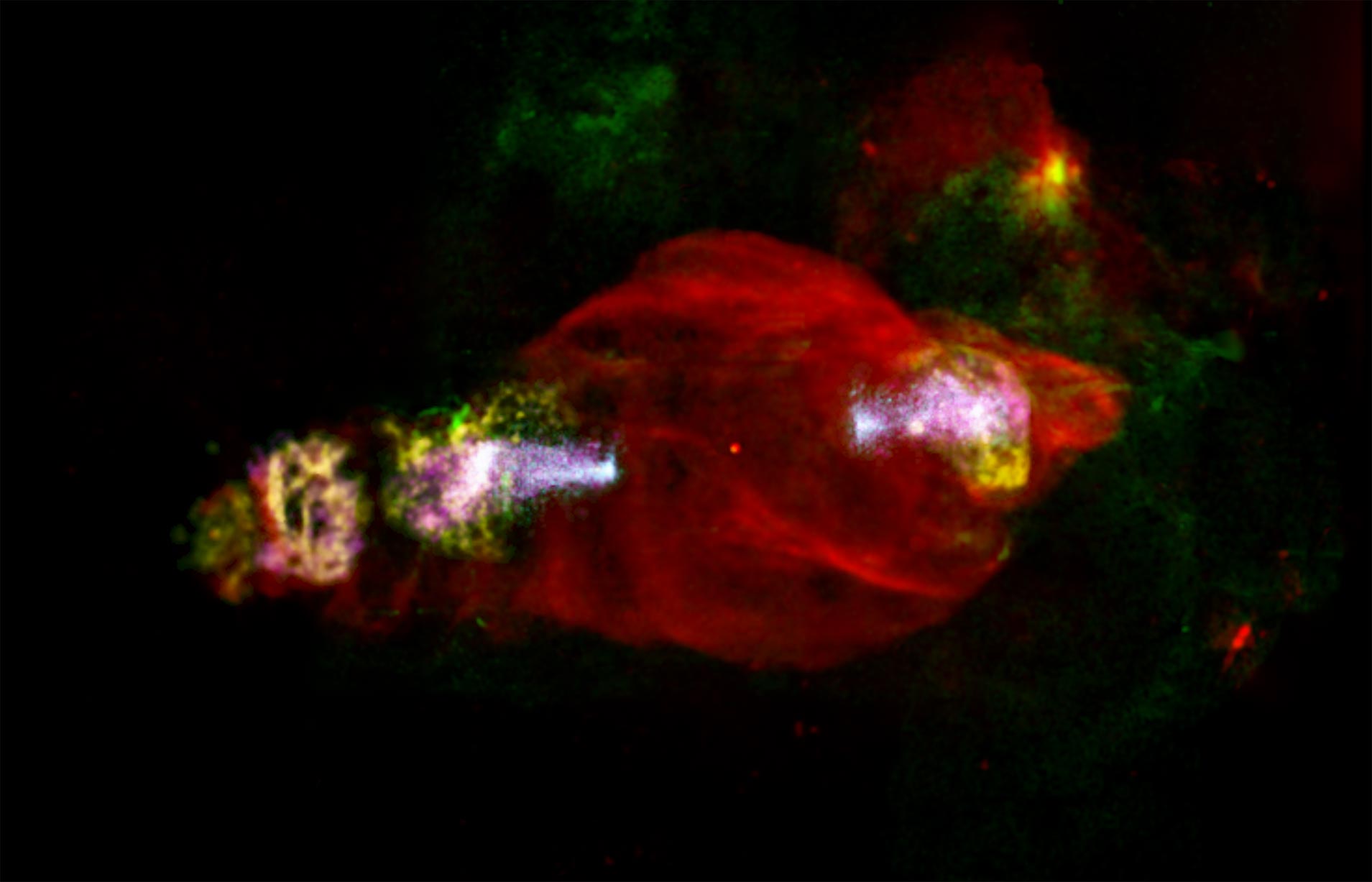

Manatee Nebula அல்லது W50, X-ray Space observatory XMM-Newton ஆல் கைப்பற்றப்பட்டது, இது ஹை த்ரோபுட் எக்ஸ்ரே ஸ்பெக்ட்ரோஸ்கோபி மிஷன் மற்றும் எக்ஸ்ரே மல்டி-மிரர் மிஷன் என்றும் அழைக்கப்படுகிறது. கடன்: S. Safi-Harb et al (2022)
ஐரோப்பிய விண்வெளி ஏஜென்சியின் எக்ஸ்எம்எம்-நியூட்டன் விண்கலம், மேனாட்டி நெபுலா என்று அழைக்கப்படும் இந்த அழகான அண்ட உயிரினத்தை எக்ஸ்-ரே செய்து, அதன் ‘தலை’யில் அசாதாரண துகள் முடுக்கம் உள்ள இடத்தைக் கண்டறிந்துள்ளது.
W50 என்றும் அழைக்கப்படும் Manatee Nebula, சுமார் 30,000 ஆண்டுகளுக்கு முன்பு ஒரு மாபெரும் நட்சத்திரம் வெடித்து, அதன் வாயுக்களின் ஓடுகளை வானத்தில் வீசியபோது உருவாக்கப்பட்ட ஒரு பெரிய சூப்பர்நோவா எச்சமாக கருதப்படுகிறது. நான்கு முழு நிலவுகளுக்குச் சமமான அளவில் பரவியிருக்கும் இது போன்ற அறியப்பட்ட மிகப்பெரிய அம்சங்களில் இதுவும் ஒன்றாகும்.
ஒரு கருந்துளை அதன் மையத்தில் உள்ளது, இது ஒரு சூப்பர்நோவா எச்சத்திற்கு அசாதாரணமானது. SS 433 என அழைக்கப்படும், இந்த மைய ‘மைக்ரோகுவாஸர்’, வாயு ஓடுகள் வழியாக குத்து, இரட்டை மடல் வடிவத்தை உருவாக்கும் ஒளியின் வேகத்தை விட நான்கில் ஒரு பங்கு வேகத்தில் பயணிக்கும் சக்திவாய்ந்த ஜெட் துகள்களை வெளியிடுகிறது.

பூமியின் சுற்றுப்பாதையில் இன்றுவரை ESA (ஐரோப்பிய விண்வெளி நிறுவனம்) உருவாக்கிய மிகப்பெரிய அறிவியல் செயற்கைக்கோளான எக்ஸ்-ரே மிஷன் எக்ஸ்எம்எம்-நியூட்டனை இந்த எடுத்துக்காட்டு காட்டுகிறது. கடன்: ESA/D. டுக்ரோஸ்
படத்தின் நடுவில் உள்ள சிவப்பு புள்ளியால் SS 433 அடையாளம் காணப்படுகிறது. எக்ஸ்எம்எம்-நியூட்டனால் பெறப்பட்ட எக்ஸ்ரே தரவு மஞ்சள் (மென்மையான எக்ஸ்-கதிர்கள்), மெஜந்தா (நடுத்தர ஆற்றல் எக்ஸ்-கதிர்கள்), மற்றும் சியான் (கடின எக்ஸ்ரே உமிழ்வு) ஆகியவற்றில் குறிப்பிடப்படுகிறது, அதே சமயம் சிவப்பு என்பது ரேடியோ மற்றும் பச்சை ஒளியியல் அலைநீளங்கள் முறையே மிகப் பெரிய வரிசை மற்றும் கிரீஸில் உள்ள ஸ்கினாகாஸ் ஆய்வகம்.[{” attribute=””>NASA NuSTAR and Chandra data were also used for the study (not shown in this image).
The nebula attracted attention in 2018 when the High-Altitude Water Cherenkov Observatory, which is sensitive to very high energy gamma-ray photons, revealed the presence of highly energetic particles (hundreds of tera electron volts), but could not pinpoint from where within the Manatee the particles were originating.
XMM-Newton was crucial in homing in on the region of particle acceleration in the X-ray jet blasting from the Manatee’s head, which begins about 100 light years away from the microquasar (represented by the magenta and cyan colors towards the left side SS 433) and extends to approximately 300 light years (coinciding with the radio ‘ear’ where the shock terminates).

The Manatee Nebula as imaged by the Very Large Array (VLA). Credit: B. Saxton, (NRAO/AUI/NSF) from data provided by M. Goss, et al.
Samar Safi-Harb of the University of Manitoba, Canada, who led the study, says “thanks to the new XMM-Newton data, supplemented with NuSTAR and Chandra data, we believe the particles are getting accelerated to very high energies in the head of the Manatee through an unusually energetic particle acceleration process. The black hole outflow likely made its way there and has been re-energized to high-energy radiation at that location, perhaps due to shock waves in the expanding gas clouds and enhanced magnetic fields.”
The nebula acts as a nearby laboratory for exploring a wide range of astrophysical phenomena associated with the outflows of many galactic and extragalactic sources and will be subject to further investigation. Furthermore, follow-up studies by European Space Agency’s future Athena X-ray observatory will provide even more sensitive details about the inner workings of this curious cosmic Manatee.
Reference: “Hard X-ray emission from the eastern jet of SS 433 powering the W50 ‘Manatee’ nebula: Evidence for particle re-acceleration” by Samar Safi-Harb, Brydyn Mac Intyre, Shuo Zhang, Isaac Pope, Shuhan Zhang, Nathan Saffold, Kaya Mori, Eric V. Gotthelf, Felix Aharonian, Matthew Band, Chelsea Braun, Ke Fang, Charles Hailey, Melania Nynka and Chang D. Rho, Accepted, Astrophysical Journal.
arXiv:2207.00573